Rainforests are some of the most complex habitats for butterflies. Known for their high humidity, they are even home to undiscovered butterfly species.
These are forests where many flowers such as passion vines grow. These provide food for different types of butterflies.
Found across the world but believed to be affected by deforestation and pollution, rainforests are still habitats for different types of butterflies.
Temperate or tropical rainforests are the home of different types of butterflies which may live in forest openings or next to rivers. Many species are even active throughout the year here.
Often living under the dense and continuous canopy, the following butterflies are well-known in the rainforest.
Table of Contents
1. Common Morpho
The Common Morpho (Morpho peleides) is a large butterfly often categorized as a subspecies of the similar blue and black Helenor Blue Morpho.

As a rainforest species, the butterfly is found across Central and South American rainforests where it emerges with dark ventral wings and bright blue dorsal wings.
Its ventral coloring brightens to nuances of brown with additional eyespots while its dorsal side darkens.
The darkening of its dorsal colors leads the species to a mostly dark blue color from a bright or azure nuance.
In addition, this is also one of the few butterfly species with faded eyespots or only partially-visible eyespots along the margins of its dorsal wings.
The species additionally shows a wide black border that runs along the edges of its forewings and hindwings.
As an adult butterfly, The Common Morpho feeds on rotting fruits and plants.
2. Thick-tipped Greta
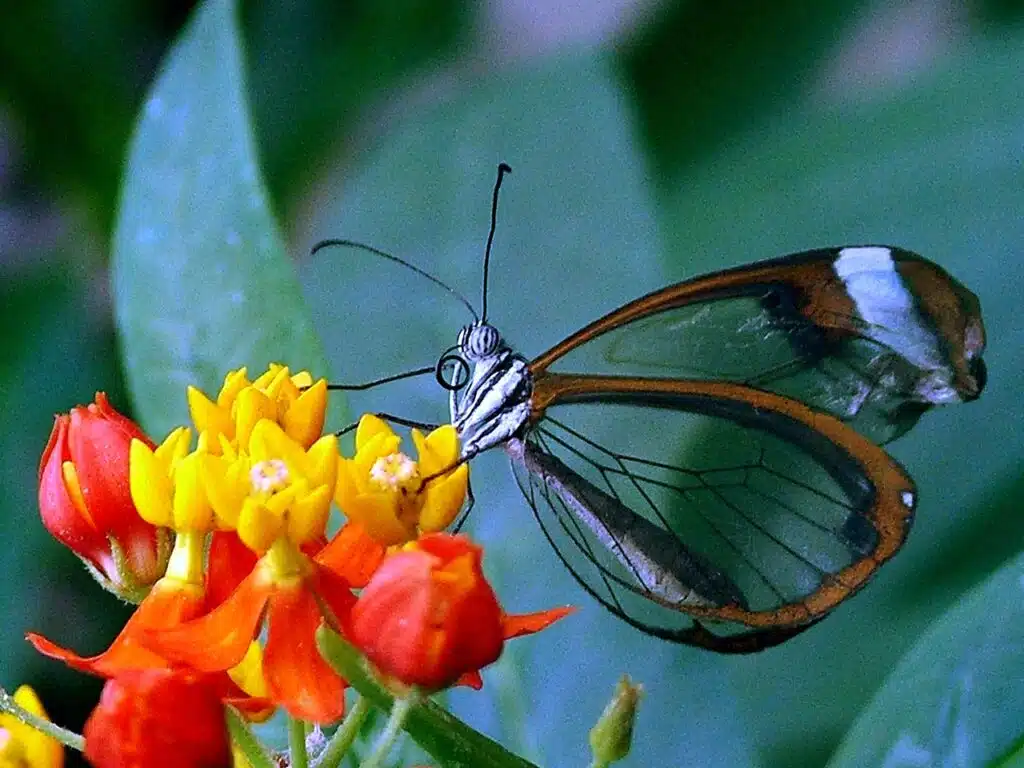
Thick-tipped Greta (Greta morgane) live in the forests of Central and South America where they reach a maximum wingspan of 2.2 inches.
Known for their clear wings, these types of butterflies have different methods of self-defense, even from an early caterpillar stage.
These types of butterflies begin life as nauseating caterpillars.
Feeding on toxic nightshade, they absorb plant toxins making them toxic to most of their predators.
As emerged butterflies, The Thick-tipped Greta is a species that has transparent wings with black veins and brown margins being the only colored sections.
This makes them not as easy to spot for different types of predators, such as birds.
Unlike other species of clearwing butterflies of the rainforest, Thick-tipped Gretas additionally show white-banded forewing tips.
3. Ulysses Butterfly
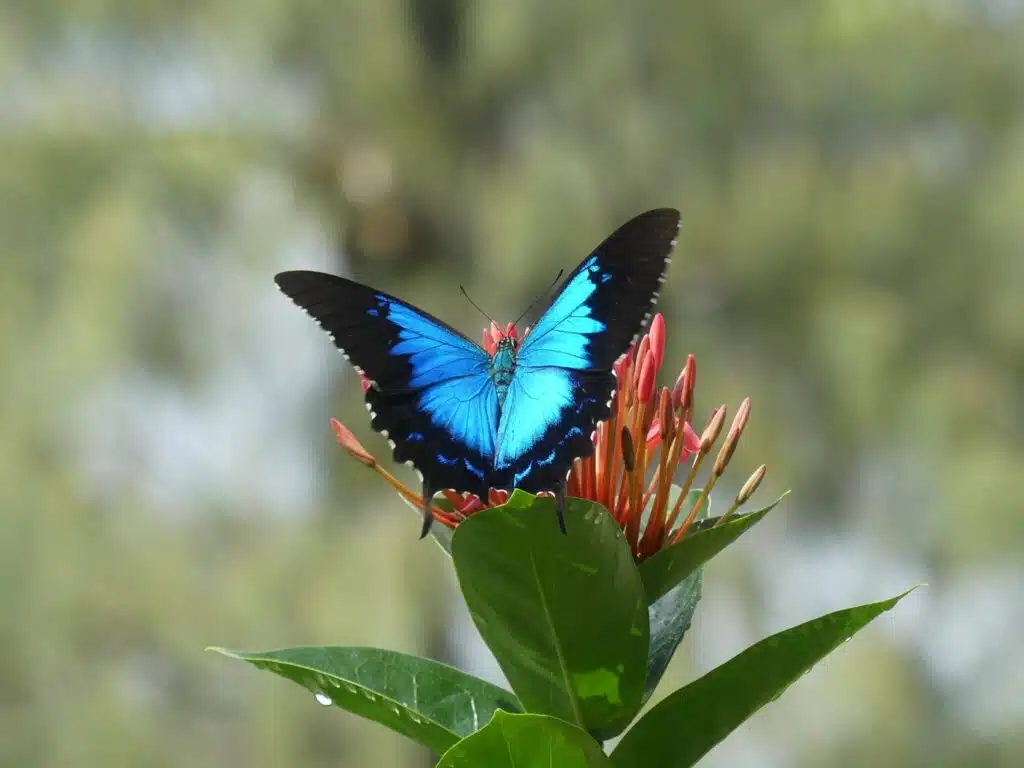
Australia’s Rainforest is also home to blue and black butterflies with a long wingspan.
Ulysses Butterflies (Papilio ulysses) are this type of a species with a wingspan of just over 4 inches.
Mostly bright blue, butterflies of the species show black veins and black margins in a color pattern familiar to tropical forest butterflies of other regions of the world.
The young caterpillar of the species features a green appearance with yellow dots and stripes to confuse potential predators about their real identity.
Some variations in the color pattern exist on the species, especially for adult butterflies which may show different black percentages on their wings.
These types of butterflies feed on small flowers on trees found in Australia’s rainforest.
Some of their preferred trees include dough wood.
4. Great Eggfly
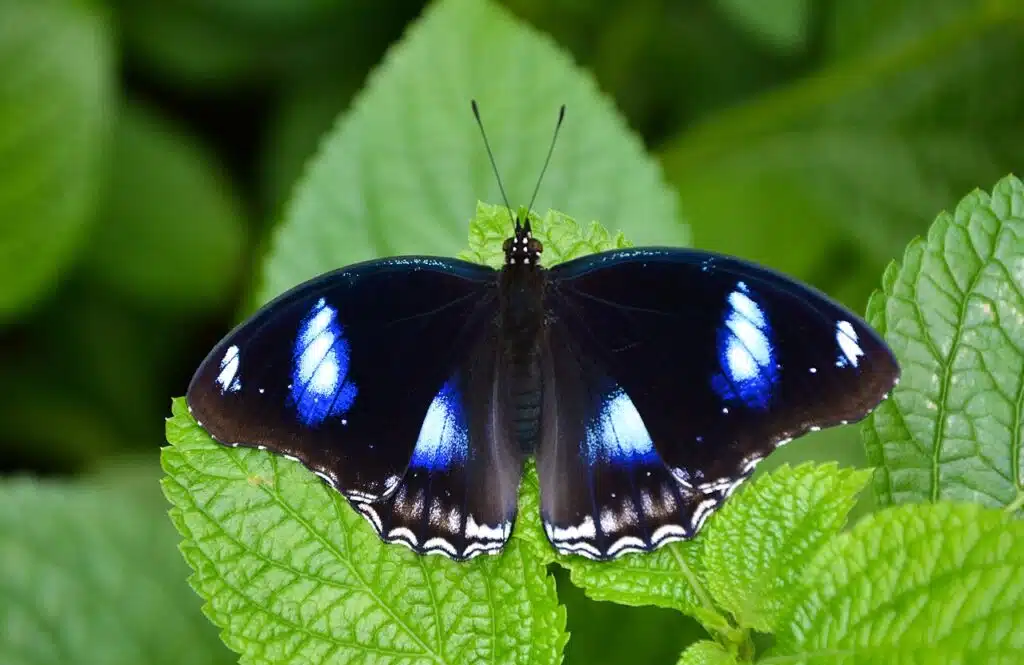
Rainforests from Asia to Australia are home to The Great Eggfly (Hypolimnas bolina).
This type of butterfly lives in both tropical and subtropical forests and it can be found as far as Japan and New Zealand.
Males and females have different patterns and colors.
Dominated by black nuances, males show white spots and bright blue spots on the forewings and hindwings, with some additional purple overlays on the blue sections.
Females are dominated by dark brown nuances and only show tan spots and margins along the hindwings and the lower forewings.
This is a species that also has brown caterpillars and which is known to favor certain host trees.
Arrowleaf sidas are among their most common hosts.
5. Doris Longwing

A species of Central and South American, Dorisn Longwings (Heliconius doris) are a species that mimic other butterflies and come in different colors or even patterns.
A blue and black pattern is often spotted in males. Blue sections are seen in its inner hindwings while white sections are seen on outs outer wings.
Its body is both black and white.
Doris Longwings are further known for having black-ground color females. Unlike blue-patterned males, females show mostly red spots and smaller white spots on their black wings.
Feeding on pollen, Doris Longwings are mainly attracted to lantana species for food which are found at low elevations around humid forests.
6. Richmond Birdwing
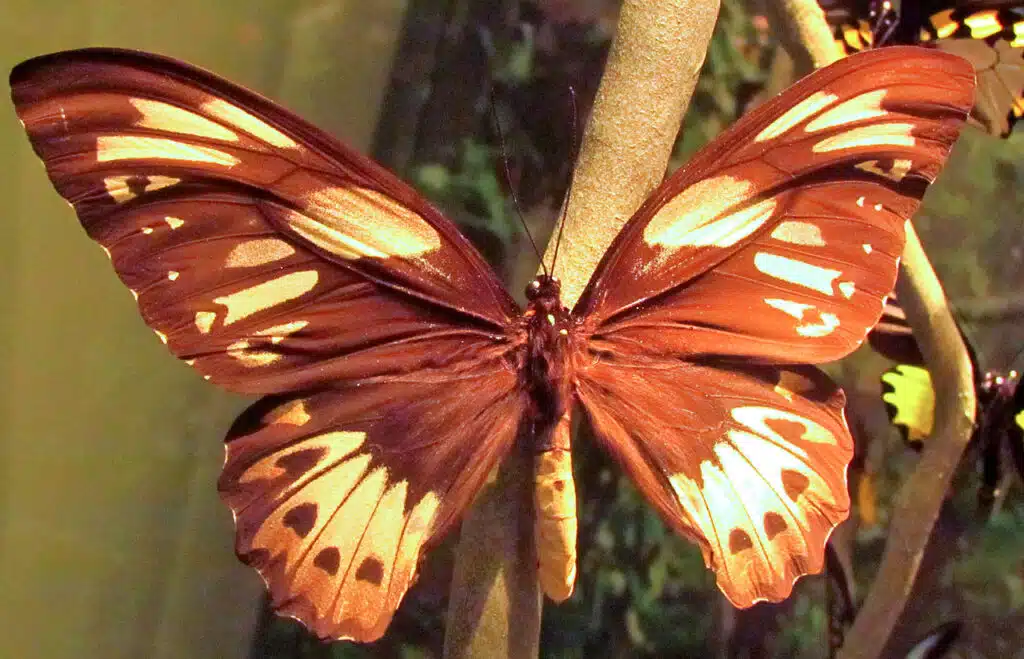
The Richmond Birdwing butterfly (Ornithoptera richmondia) is found North of Brisbane and in Australia’s rainforest.
A multicolored butterfly also mostly black, this is a species that is associated both with dense rainforests and with clearings.
These butterflies spend their lives up among tree leaves in dense forests and they establish breeding territories in rainforest clearings.
These types of openings are areas where males can become territorial and drive other males away but not females.
Flying around the female, they try to attract them with pheromones.
Adult male Richmond Birdwing butterflies are mostly black with green, green-blue, and black spots on the wings.
They show similar patterns on the ventral wings with additional yellow sections.
7. Cairns Birdwing
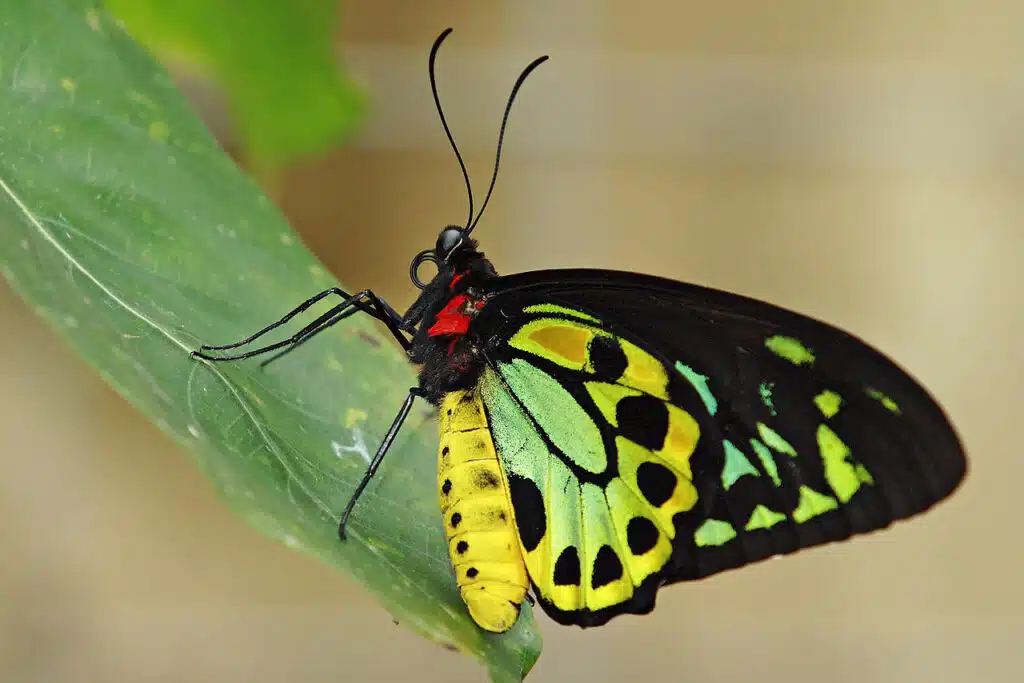
One of the native species of Australia, Cairns Birdwings (Ornithoptera euphorion) shows a combination of black, yellow, green, and bright blue nuances across males and females.
The male of the species often comes only in green and black dorsal wings, with specific black veins.
Female butterflies of the species are larger, sometimes even 1 inch larger.
Blue, yellow, and black colors are specific to the ventral wings of the females.
These types of butterflies have caterpillars that feed on birthwort, a type of toxic plant. The caterpillars absorb the toxins of the plant which are then transmitted to adult butterflies.
As a species, Cairns Birdwings are avoided by some predators given their bad taste.
8. Tiger Leafwing

Found in Central and South America, Tiger Leafwings (Consul fabius) are a species found across different forests, including rainforests.
Mostly common in The Amazon Basin, Tiger Leafwings take on the appearance of leaves to avoid predation.
Brown patterns similar to dead leaves are specific to their ventral wings while their dorsal wings are dominated by brighter brown nuances, orange, and yellow.
This is also a species that shows black wing margins plus considerable black sections on the inner hindwings.
Some Tiger Leafwing subspecies additionally show white sections on the forewings. These are small white dots and stripes.
Apart from the adults which look like dead leaves from some angles, the caterpillars also have a green rolled leaf-like appearance.
9. Tiger-Mimic Queen
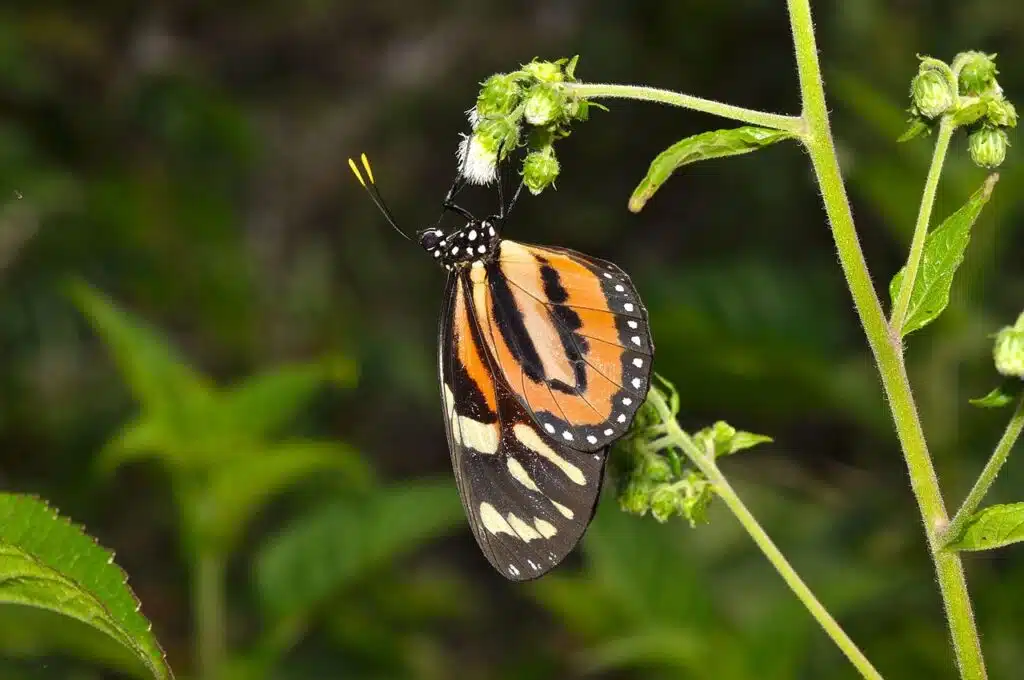
A species of Central and South American rainforests, Tiger-Mimic Queens (Lycorea halia) are named after their striped tiger-like appearance.
Orange, black, brown, and cream colors are all specific to these stripped butterflies.
The species shows black margins and brighter stripes on the forewings with partially black lower hindwings and a dark body.
Interestingly, both the ventral and the dorsal sides of the species look almost completely the same, a rare occurrence in butterflies.
A long wingspan and a rainforest presence are specific to the species
Smaller Tiger-Mimic Queen populations are also found in other regions of the world, but most live in Peru, Brazil, Ecuador, and Venezuela.
10. Disturbed Tigerwing

With more orange sections across the wings compared to The Tiger-Mimic Queen, The Disturbed Tigerwing (Mechanitis polymnia) also has a striped appearance.
This is a species with black stripes across mostly bright orange hindwings and white sections across its black forewing tips.
Also found in The Amazon Basin, The Disturbed Tigerwing only grows to a size of around 3 inches.
Bright brown nuances are specific to its lower hindwings while its ventral body is white or bright yellow.
Caterpillars of the species feed and live on fruit-bearing plants of the rainforest.
11. Elegant Acraea
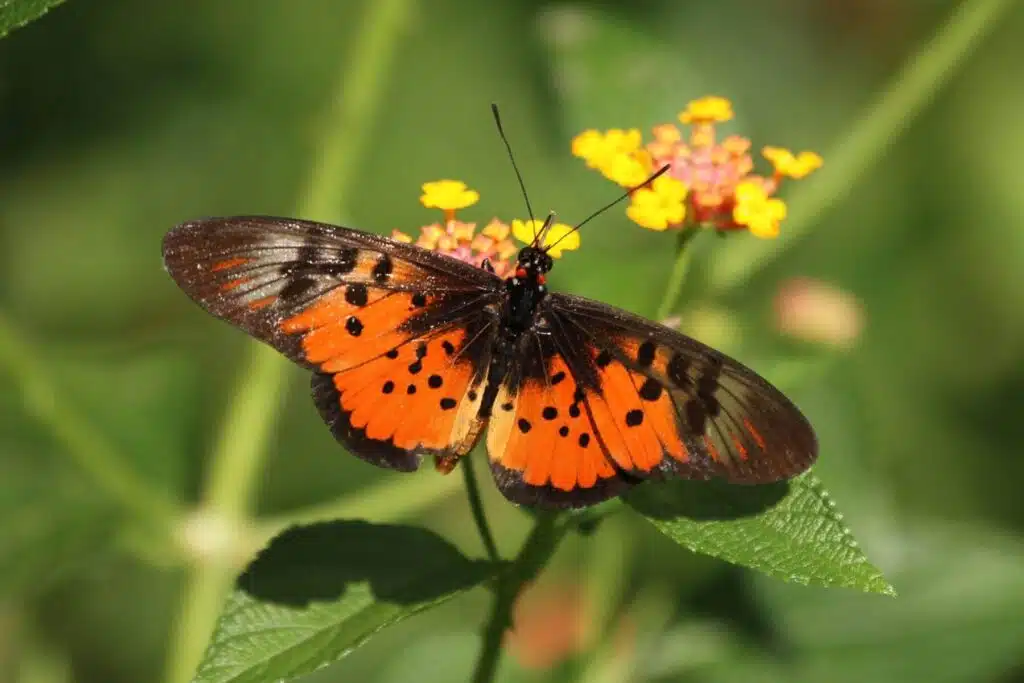
A type of sub-Saharan Butterfly, The Elegant Acraea (Acraea egina) lives in the rainforest and also in other drier climates.
With a short wingspan of up to 2.6 inches, this species has distinct smoky-brown forewings and orange-brown hindwings.
In addition and as opposed to how most butterflies look, the forewings are slightly transparent, with black spots and black stripes.
Its body is also partly white with a mostly black upper section.
There are 4 Elegant Acraea subspecies and a distinct black and yellow caterpillar.
Groups of spines are seen along the dorsum of these caterpillars, together with black and yellow prolegs.
12. Four-Barred Swordtail
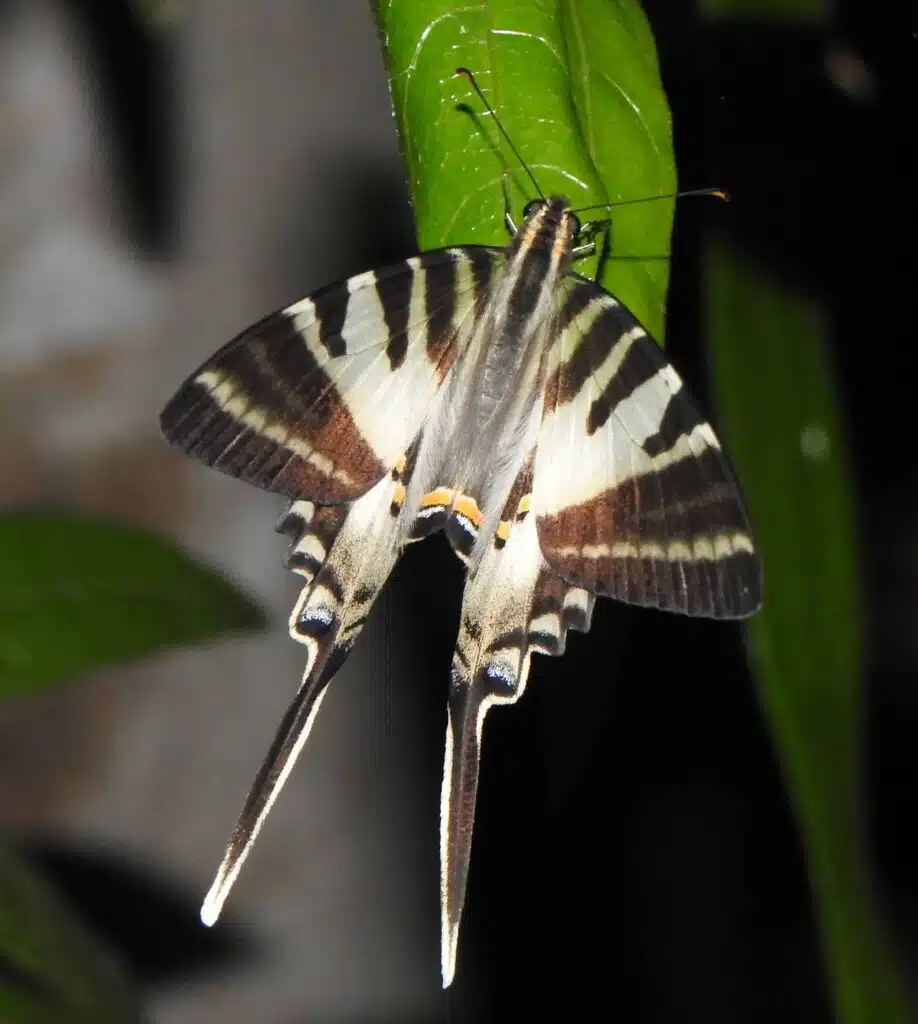
Native to Australia, The Four-Barred Swordtails (Protographium leosthenes) are named after the number of brown bars on their wings.
This is a species with 4 faded brown bas of a vertical orientation across the forewings and hindwings which resembles its larger relative, The Five-Barred Swordtail.
Its caterpillars range from pale green to dark green with age.
The ventral side of the adult butterfly can sometimes show small yellow dots and half-moon-shaped blue eyespots.
This species feeds on various vines and is always found close to the ground in the rainforest.
13. Isabella’s Longwing
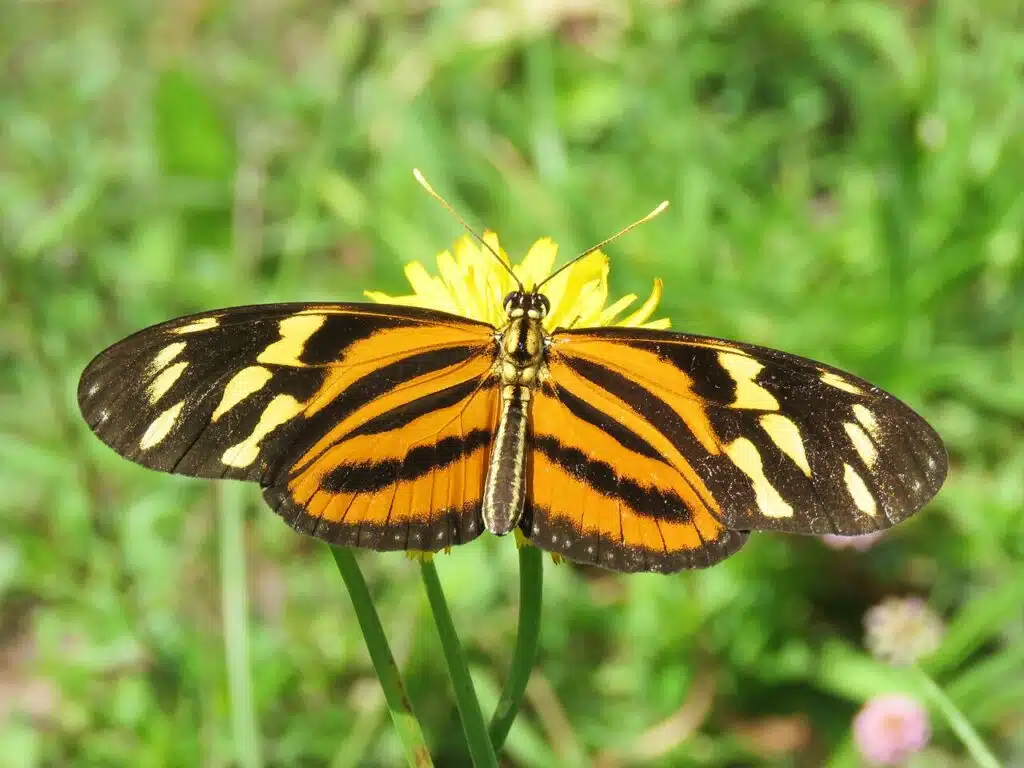
A species of The Amazon Basin, Isabella’s Longwings (Eueides isabella) are types of striped butterflies in the rainforest.
Orange and black nuances dominate their tiger-like colors and patterns while small blue or orange dots can be spotted on their dark brown or black margins.
Bright orange and dark orange are both specific to the butterfly which shows the darker nuances on the hindwings.
Its widespread tropical habitat allows this species to find plenty of flowers to feed on and lay eggs on.
This is a species that lives in tropical and subtropical climates which means it’s also active throughout the year.
14. Common Posy
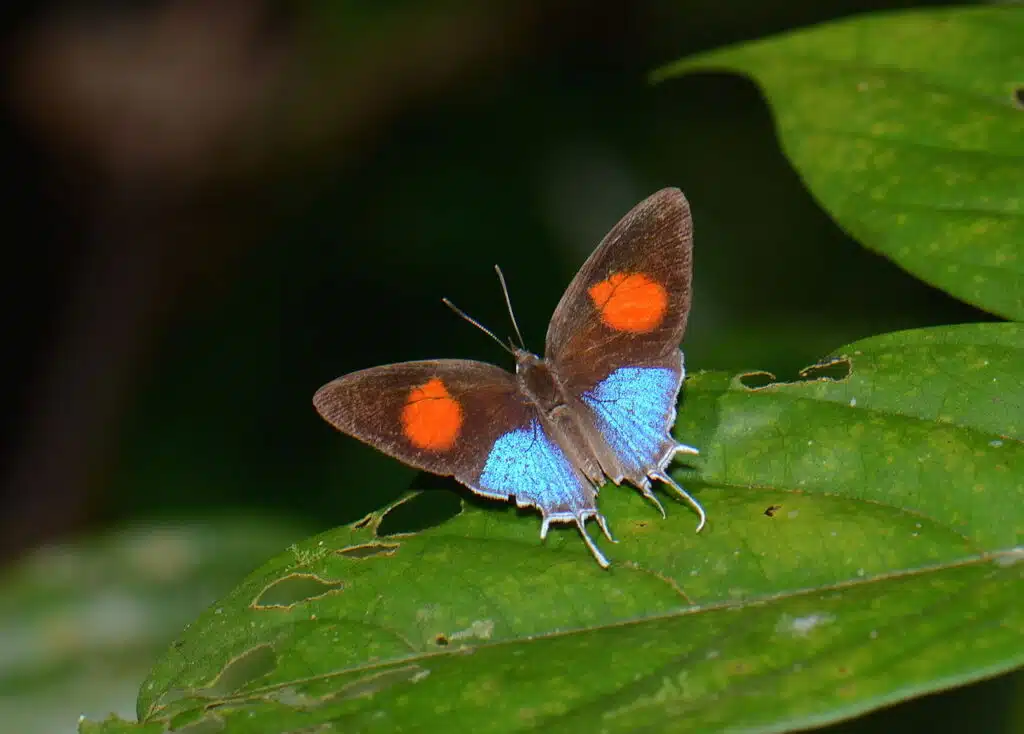
An Asian native, The Common Posy (Drupadia ravindra) and its subspecies are dark dorsally and bright ventrally.
Males are mostly dark brown with blue lower hindwing patches and faint orange stripes on the forewings.
They can also be black and blue, brown and blue, or white and black.
White and orange sections are mostly specific to the ventral wings of the species with additional black spots on the white sections.
Apart from its high number of subspecies and its variable coloring, this is also one of the smaller butterflies of the rainforest.
Even the largest Common Posy butterflies measure up to 1.4 inches.
15. Blue Wave

Slightly larger than The Common Posy but also small, Blue Wave butterflies (Myscelia cyaniris) are also native to the rainforest.
Found along The Atlantic, these Central and South American species have a striped or wave-like appearance.
A black ground color is contrasted by white and bright blue wave-shaped stripes.
The ventral wings of the species look more like dead leaves with brown sections and white sections and aren’t as colorful as the dorsal sections.
Found in the tropical rainforests of Honduras or Costa Rica, this is a species that reaches a wingspan of up to 1.4 inches and flies just above the ground.
The species prefers rotting fruit to plant nectar.
16. Amber Daggerwing
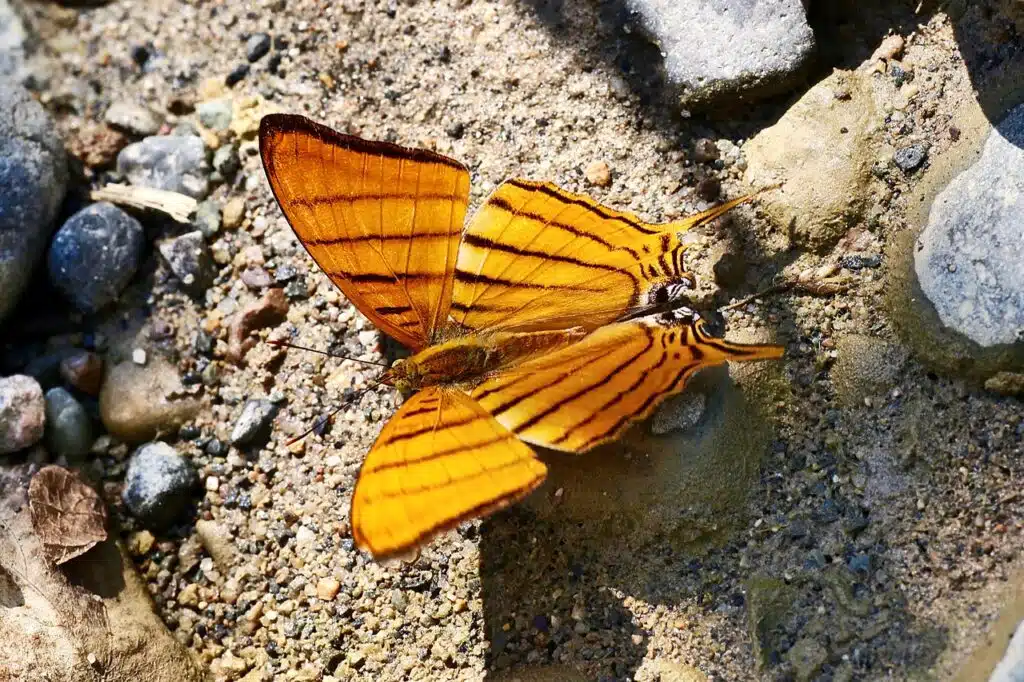
Native to Central and South America, The Ambver Daggerwing (Marpesia berania) is a species that lives in the rainforest.
It features amber-orange ground colors with black stripes on the forewings and hindwings. It additionally features black margins across the wings.
This is a species sometimes associated with fig trees as possible host trees for its caterpillars.
While it lives in the rainforest, The Amber Daggerwing doesn’t live throughout the year as many other species here.
It lives for around 6 months, despite its large size.
This is a species that lives in large groups, often of up to tens of males and females.
This is a species that can be spotted feeding close to the ground or on the ground.
It’s here that its ventral wings are shown as butterflies resting with their wings together to avoid drawing in too much attention.
Gray-cream colors are specific to its ventral wings which show orange stripes and not black stripes as the dorsal wings.
17. Rainforest Brown
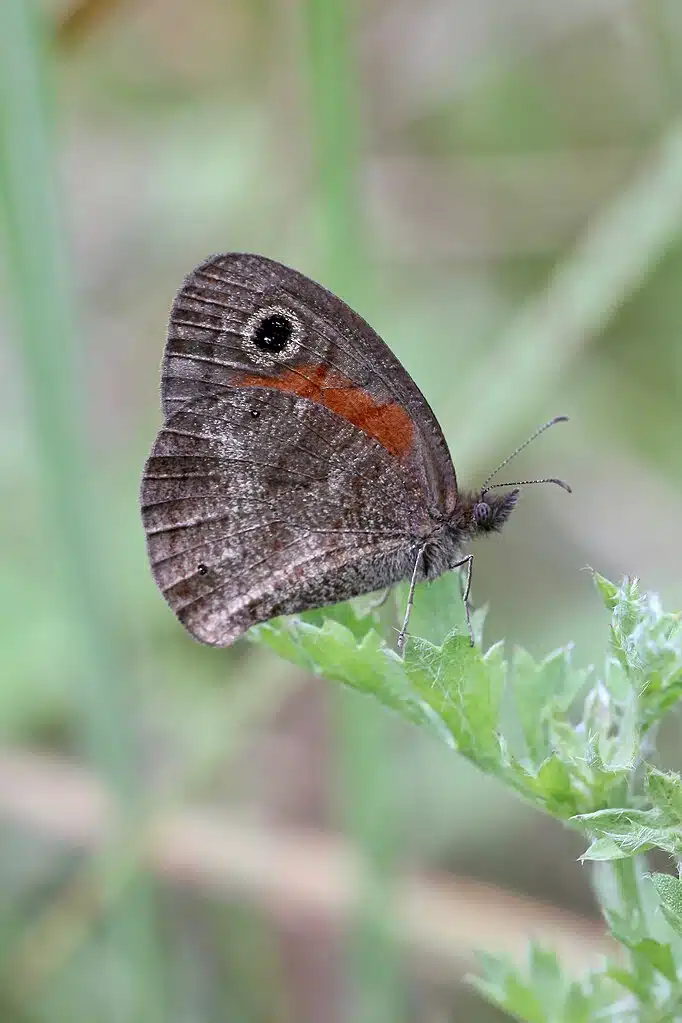
This representative rainforest species (Cassionympha cassius) is native to Africa. It can be found across multiple types of forests and it’s identified by its unique appearance.
6 eyespots of various sizes are seen on its dorsal wings. There are on larger eyespots on each forewing and 2 smaller eyespots on each lower hindwing.
Black and yellow, the eyespots additionally feature a tiny white central section that mimics light reflection in the eyes.
Rust-red sections are also seen next to the larger eyespots while most of their wings have a maroon nuance.
Females have a similar appearance but their ground color is gray-brown and are also seen flying close to the ground.
18. Red Flasher
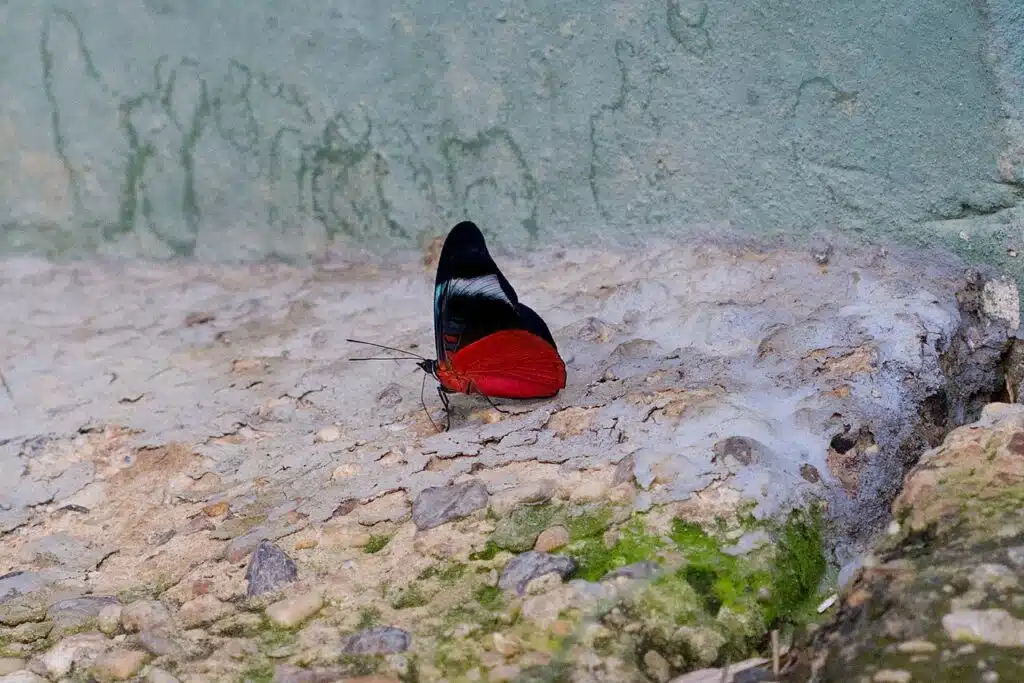
A species of Central and South America, Red Flashers (Panacea prola) are found across humid rainforests.
Butterflies of this species grow to a maximum wingspan of just over 2 inches.
They feature a multicolored appearance and crimson-red nuances.
Forewings are more colorful, showing wave-shaped blue and black patterns while their hindwings are almost completely crimson red.
Small red dots are also seen on the lower forewings. Red Flashers also show this type of red nuance across their ventral wings.
A species of low elevations, Red Flashers may be seen along mountain ranges, but at low elevation.
19. Dirce Beauty
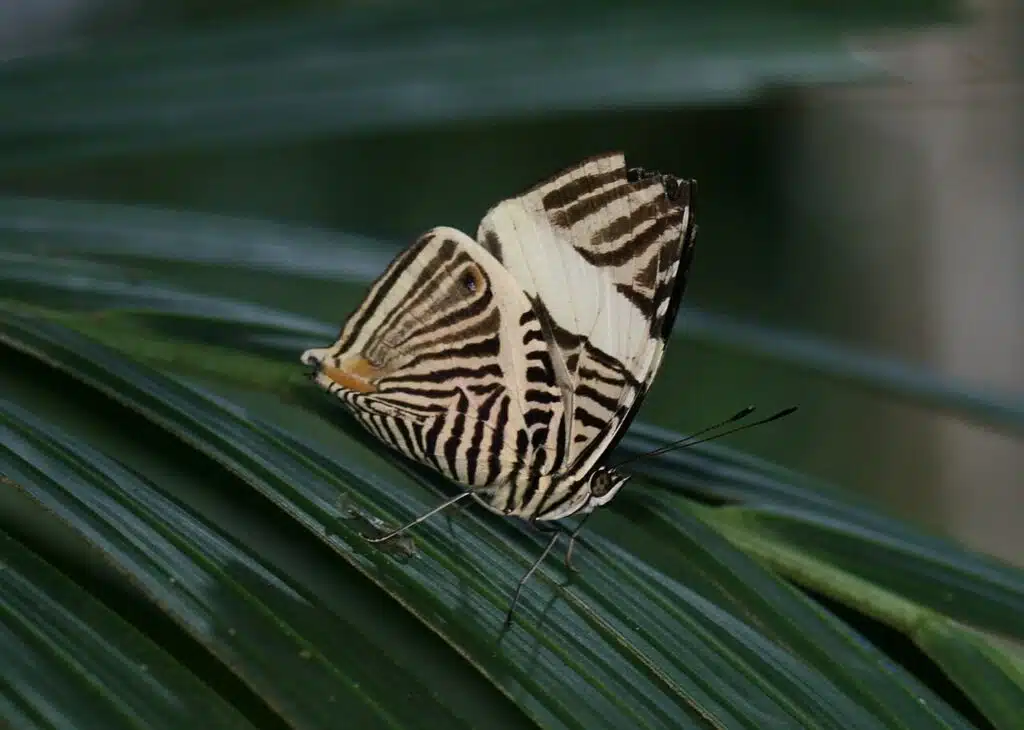
Largeleaf deciduous trees in tropical regions are the hosts of Dirce Beaty (Colobura dirce) and their caterpillars.
A species of Southern Central America and Northern South America, Dirce Beauty are some of the most contrasting rainforest species when it comes to dorsal and ventral appearance.
These butterflies have dark brown dorsal wings with yellow diagonal bands on the forewings and bright brown inner sections on the hindwings.
Their ventral wings resemble the patterns of zebra butterflies. A combination of black and brown patterns on the ventral wings makes the species resemble zebra butterflies.
A zebra-like ventral body is also specific to Dirce Beauty butterflies.
20. Separated Stripestreak
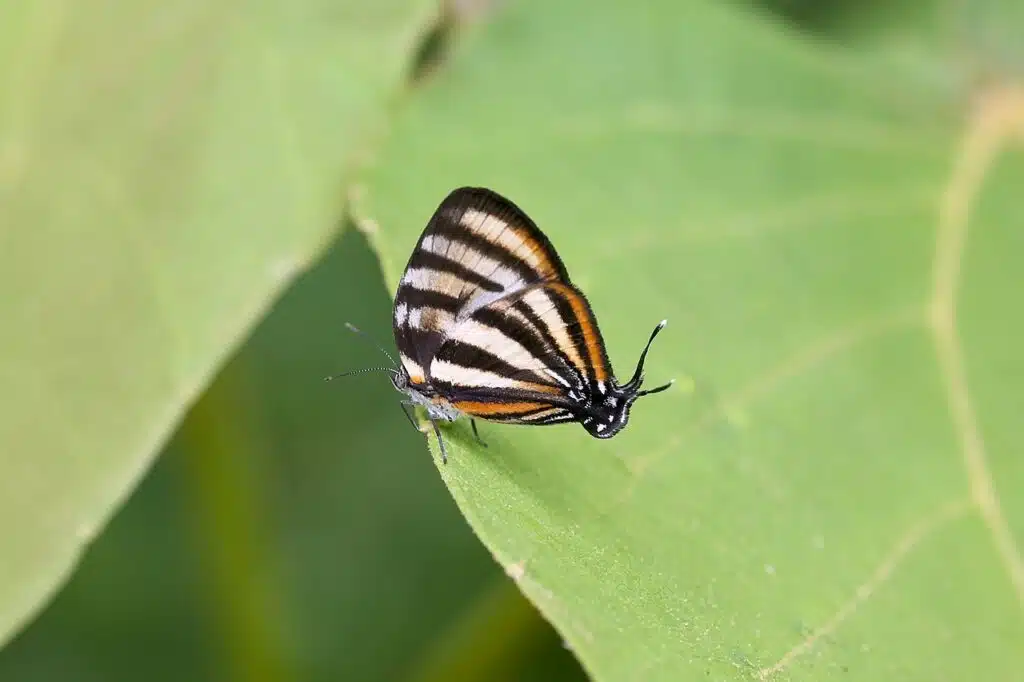
A striped appearance is also specific to the Separated Stripestreak (Arawacus separata), a species dominated by white, cream, or yellow base nuances.
The dorsal wings of the species have an off-white ground color with black stripes.
Similar patterns are seen on the dorsal wings, with an additional brown or orange stripe along the upper forewings.
A small species flying low, The Separated Stripestreak has bright green caterpillars with short white hairs which mimic the hairy leaves they live and feed on.
21. Periander Metalmark

From Mexico to Argentina, The Periander Metalmark (Rhetus periander) is among the multiple species of black and blue butterflies in the rainforest.
This is a species with tail-like elongated lower hindwings with dark blue inner wings and black outer wings and margins.
Only a few small red dots contrast the appearance of the lower hindwings.
Black dominates their ventral wings which also show white bands and patterns.
Some color variations are seen along its 4 subspecies. Brown and white dorsal wings are seen on some of its subspecies but with similar red dots on the lower hindwings as well.
22. Apricot Sulphur
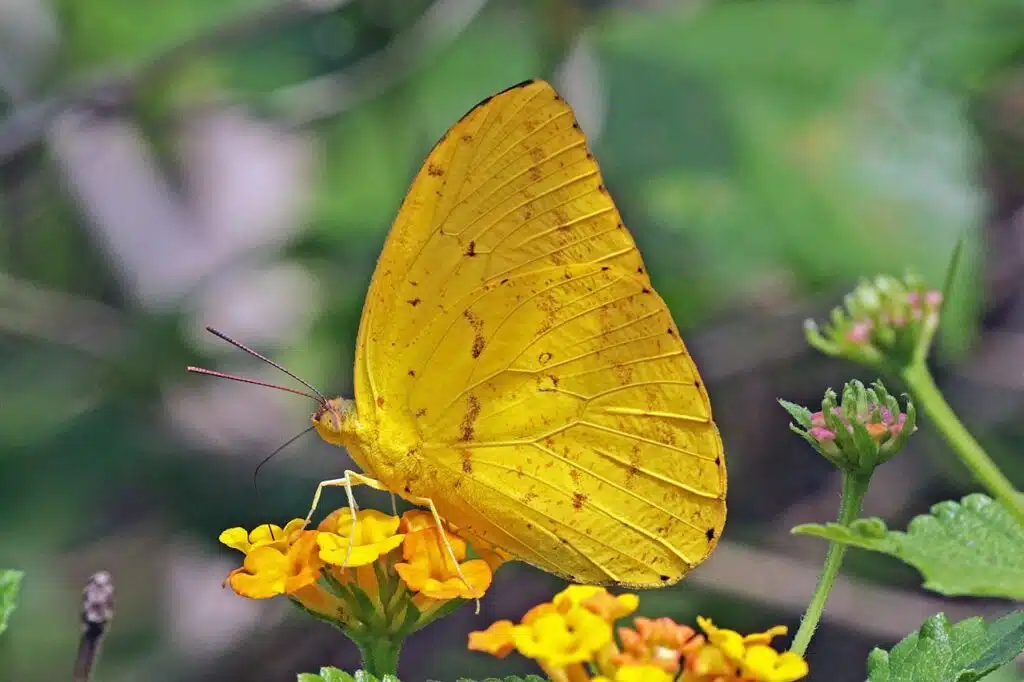
A species that lives in a wide range of forests from Mexico to Peru, Apricot Sulphurs (Phoebis argante) have a bright apricot-orange color across the dorsal wings.
Males also have similar ventral wings while females have mint-green wings.
These types of rainforest butterflies are dependent on leguminous trees such as those of the Pantaclethra genus.
They can also feed on mud in a habit known as puddling. Tens and hundreds of butterflies puddle, feeding on the minerals in the ground soon after it rains.
23. Unspotted Firewing

Named after the appearance of its males, The Unspotted Firewing (Catonephele acontius) is one of the black butterfly species of the rainforest.
These types of butterflies show mostly black wings and a bright orange band across them.
Females of the species are also black but show rows of parallel interrupted white bands or yellow bands.
White ventral wings are seen on these butterflies with black cloud-like patterns.
Flying below the canopy, this is also a species with weird-looking caterpillars. A base green color is specific to these caterpillars.
However, they show rows of spines along the back together with a pair of long black antennae-like spikes.
24. Variable Cracker

Some species of the rainforest take on the appearance of their habitat. This is done to different extents.
The Variable Cracker (Hamadryas feronia) is among the species which mimic their environment completely. They take on the appearance of their host tree’s bark.
Its range expands to the tropical and subtropical areas of The Americas and feeds on rotting fruit.
Perching is common in the species which prefers dark and bright bark alike.
This is a species with multiple brown patterns across the wigs, gray areas, and brown eyespots.
Males are found in brighter bark while females perch on darker bark.
They become difficult to spot when perching. Even the ventral patterns of these butterflies make them conspicuous.
This side is dominated by tan and black patterns.
Similar conspicuous colors and patterns are seen on the caterpillars of the species which have dual colors.
They can be blue and black or brown and white.
With a wingspan of up to 3 inches, Variable Crackers are active throughout the year in the warmest parts of their range and up to December in its Northern parts (including the Southern Texas strays).
25. Penelope’s Ringlet

Multiple species with eyespots are specific to the rainforest.
Penelope’s Ringlet butterflies (Cissia penelope) are among the brown species with eyespots found in the rainforest.
Bright brown nuances are seen across their dorsal wings. This is also a species with 4 small eyespots.
There are 2 eyespots across the forewings and 2 eyespots across the hindwings.
6 eyespots are also specific to the ventral side of these butterflies.
Tan ground colors are specific to the ventral sides of these butterflies which additionally show dark brown stripes.
Reaching a wingspan of up to 2 inches, this is a low-flying species found in dense forests and forest openings.
26. Scarce Bamboo Page

One of the species also found at higher altitudes of the rainforest is The Scarce Bamboo Page (Philaethria dido).
A species of The Americas, the butterfly is also seen in Southern Texas on some years.
This is a type of butterfly that prefers habitats along rainforest streams. It lives at lower and higher elevations of up to 4.000 feet in rainforest clearings as a secondary habitat.
This is a dual-color species with bright green and black nuances across the wings.
Yellow-green nuances dominate its dorsal and ventral wings while black margins and patterns contrast the bright appearance.
Females of the species can also show more yellow sections across the dorsal wings while some males show blue-green coloring on the ventral wings.
A species also found on beaches, these types of butterflies can be an indicator of the mineral-rich soils of the rainforest.
Apart from its vivid colors, The Scarce Bamboo Page is also a species that can perch upside down.
27. Malachite
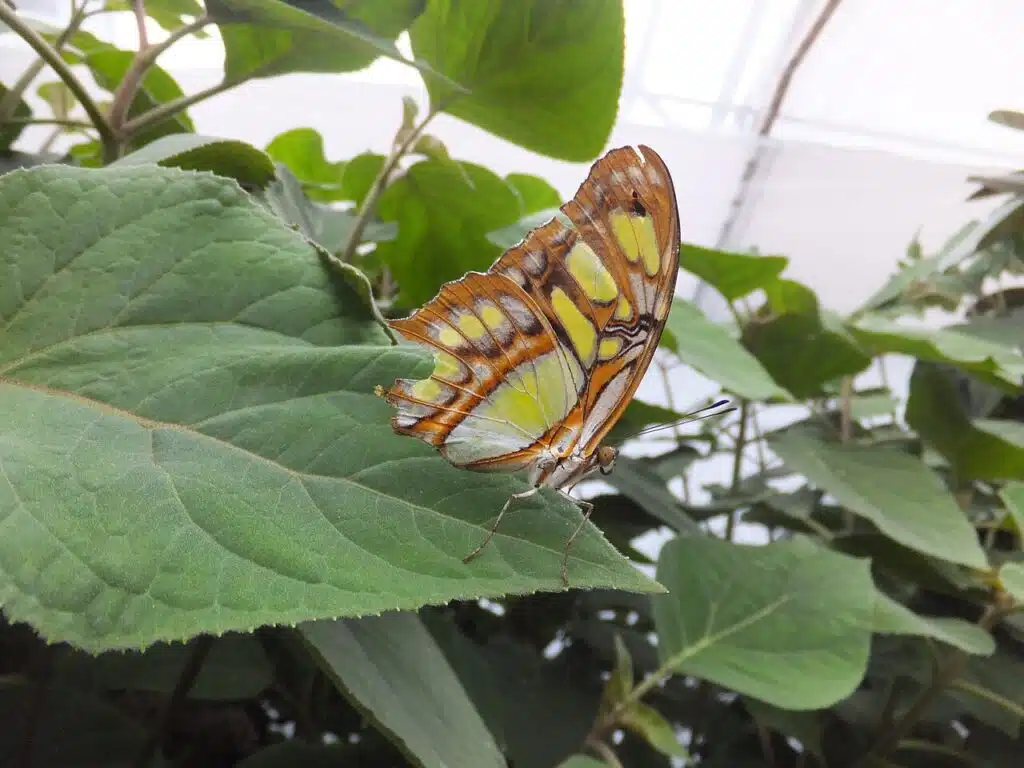
Malachite butterflies (Siproeta stelenes) are named after real green malachite.
These butterflies are mostly green but can also be yellow-green. Both these nuances are paired with black margins and patterns.
A similar malachite nuance is seen on its underside which shows brown contrasting patterns instead of the black patterns seen on the dorsal wings.
A tropical species, Malachite butterflies live in Central and South American rainforests and can grow to a wingspan of up to 4 inches.
These types of butterflies rely on the herbs in the rainforest as host species for their spiny caterpillars.
Adults, on the other hand, eat dead plants and animals. On occasion, they can eat nectar from the flowering herbs they lay eggs on.
28. Red Postman

Dark, numerous, and specific to the rainforest, Red Postmans (Heliconius erato) or Little Postmans are among the multiple species to feed on passifloras.
This type of plant is a rare sight given the number of caterpillars of various species that feed on it.
The years with more flowers also mark the years with extra Red Postmans.
A butterfly also known for its tens of subspecies, the Red Postman has a mostly black color with red or pink-red bands across the wings.
Its spiny green and often black and yellow caterpillars are also avoided by predators due to their spines.
These butterflies are rarely seen on their own as they’re active and aggressive. Males are often spotted next to a chrysalis awaiting an emerging female.
29. Numata Longwing

A species of South American rainforest, Numata Longwings (Heliconius numata) is found in The Amazon Basin.
This large type of butterfly feeds on orange and red flowers and this also impacts its dominant colors.
Orange-red and yellow are among the primary colors of the butterfly which additionally exhibits black forewing tips and black wing margins.
Also known for its color variation with its 28 subspecies, Numata Longwings occur at all elevations up to 5.000 feet.
The butterfly flies close to the ground, in forest clearings and edges.
30. Tiger Beauty

Tiger Beaty butterflies (Tigridia acesta) are found in The Amazon Rainforest.
Butterflies of this species have distinct tiger-like patterns which include both the dorsal and the ventral wings.
Its dorsal nuance is brown, with black mostly specific to its forewings.
The tiger-like pattern is spotted on its ventral wings which are yellow and yellow-pink with narrow and wide stripes.
Found in Brazil, Colombia, and Ecuador, this is also a species that can have mostly black dorsal colors, depending on its subspecies.
31. Uncertain Owlet
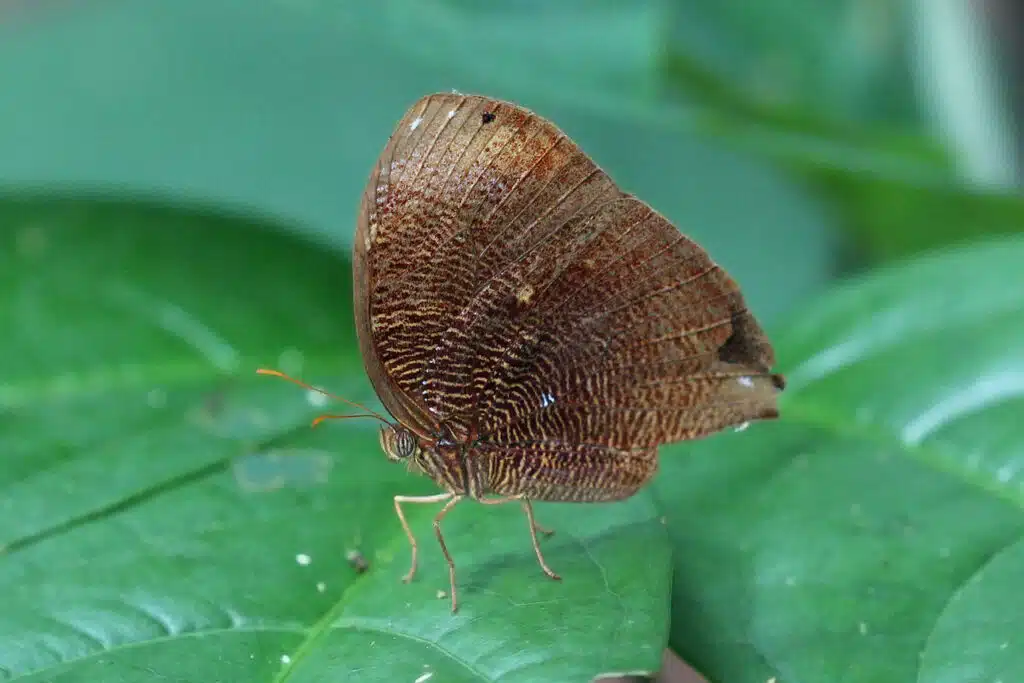
Another species of The Amazon, The Uncertain Owlet (Bia actorion) is a dark butterfly that flies low.
It does this because it feeds on the small palms found in these rainforests as a
caterpillar.
Both its ventral and dorsal appearance are characteristic of a leaf-mimicking species.
Dark brown on both sides, the butterfly looks like a dead leaf.
Butterflies feed on the seeds of their favorite palm trees. The small gray seeds of murumuru are among their most common foods.
32. Spangled Cupid
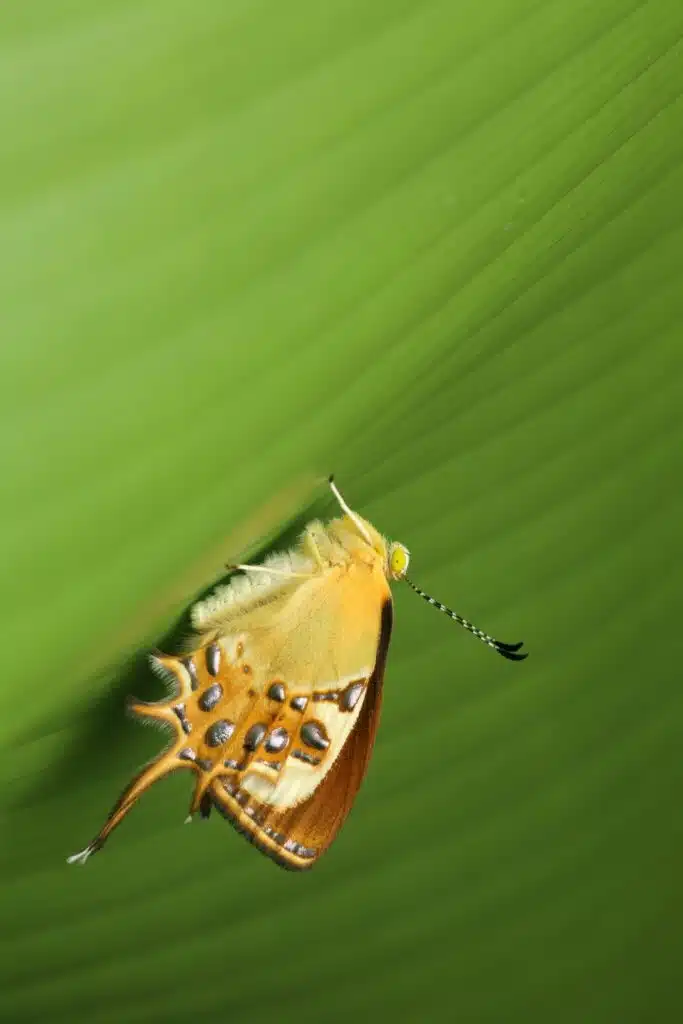
Spangled Cupids (Helicopis cupido) have atypical colors among all of the butterflies in the rainforest.
These are white, off-white, and even silver.
Its dorsal wings are off-white or cream with wide brown and dark brown margins.
White ventral wings of Spangled Cupids are decorated with silver spots and bright brown margins.
Even the caterpillars of Spangled Cupids are distinctly colored as they’re partly red.
33. Banded Orange Heliconian
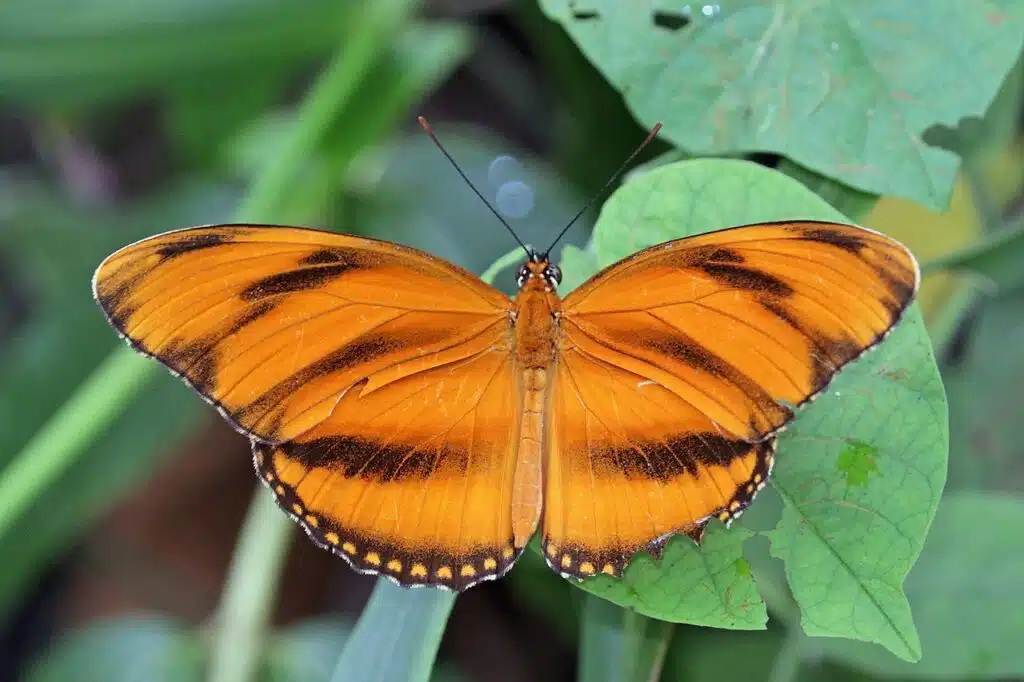
Central and South American forests are home to The Banded Orange Heliconian (Dryadula phaetusa).
This species of banded rainforest butterfly grows to a wingspan between 2 and 3.5 inches and has common orange and black patterns.
Bright orange ground colors are specific to this species which additionally shows black stripes and margins.
As tens of other rainforest butterflies, Banded Orange Heliconian feed on passionflowers or passion vines which are found in high numbers in the rainforest.
While resting, the butterfly doesn’t look as bright or as colorful as the flowers of passion vines as it’s mostly black ventrally.
On occasion, male Banded Orange Heliconian can be seen together, feeding on mud moisture straight from puddled.
34. Cynosura Eighty-Eight
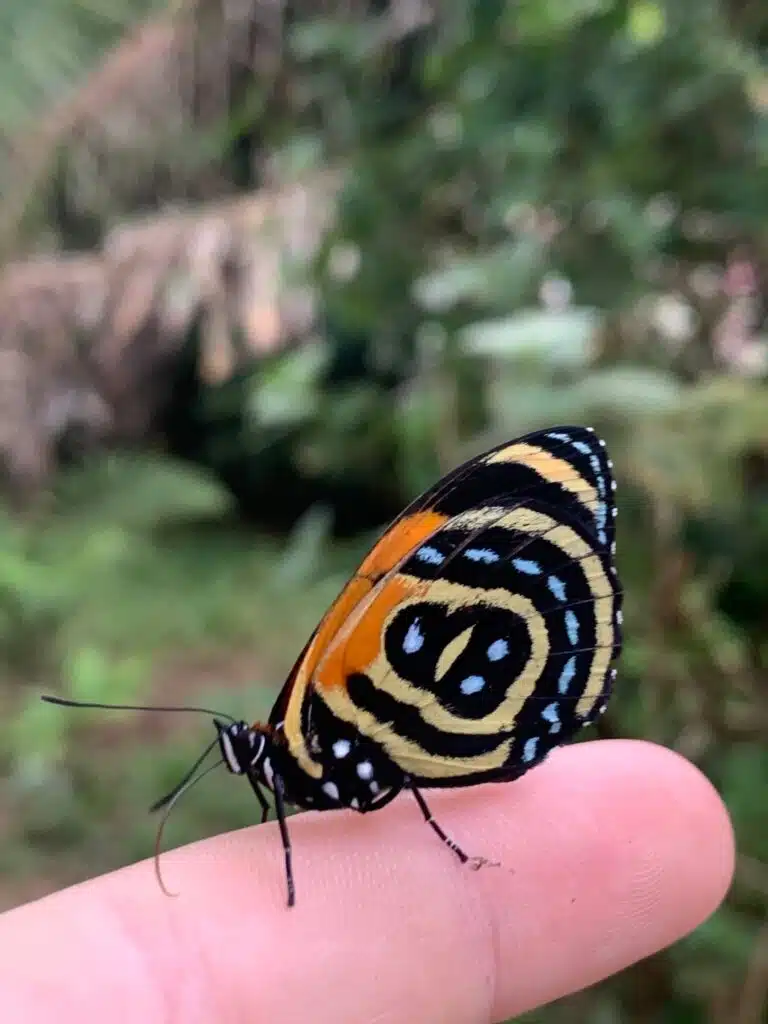
From Colombia to Brazil, Cynosura Eighty-Eight butterflies (Callicore cynosura) are a common species.
These butterflies are named after the patterns on their hindwings and ventral wings.
These are B and D-shaped yellow and brown patterns which prompt its nickname of BD Butterfly.
Its forewings are mostly black, with contrasting red marks believed to act as a warning sign of possible toxicity to predators.
These butterflies grow to a wingspan of up to 1.8 inches.
35. Blue-Frosted Banner
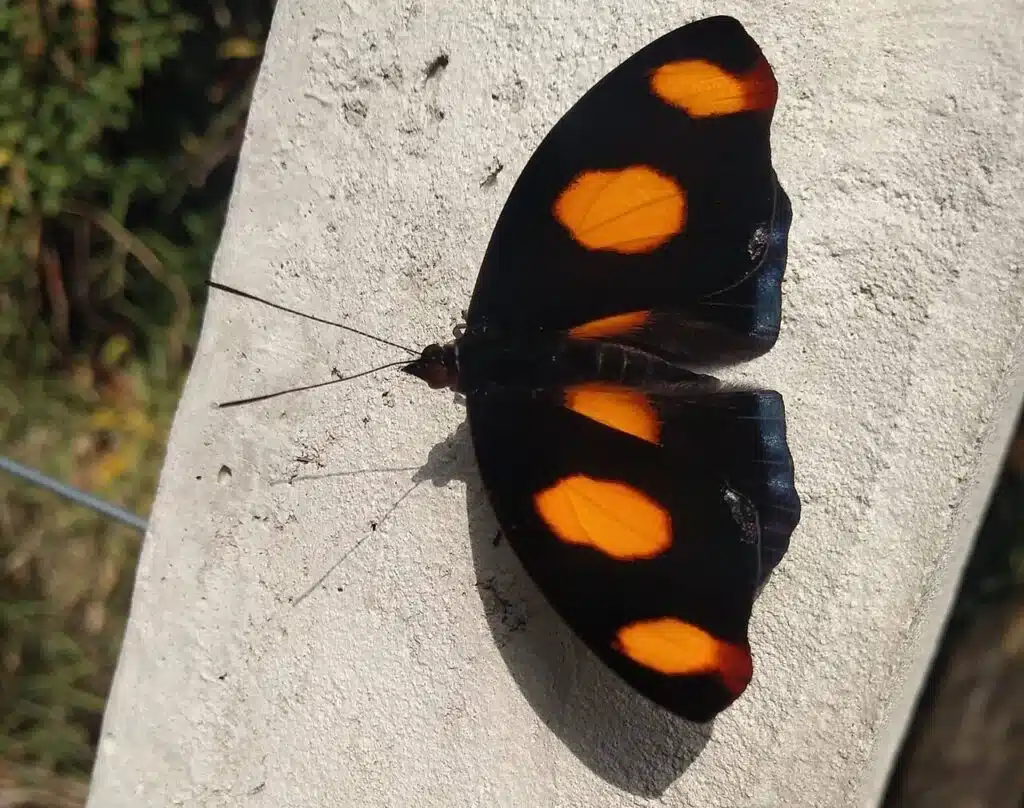
Blue-Frosted Banner butterflies (Catonephele numilia) are among the rainforest species with considerable appearance differences between males and females.
The male Blue-Frosted Banner features black ground coloring with 6 orange spots across its forewings and hindwings.
Females of the species have brighter brown nuances with long yellow stripes along the wings.
Like other butterflies of the rainforest, they feed on rotten fruits and animal dung. Tropical and subtropical Alchornea rotten fruits are among their common foods.